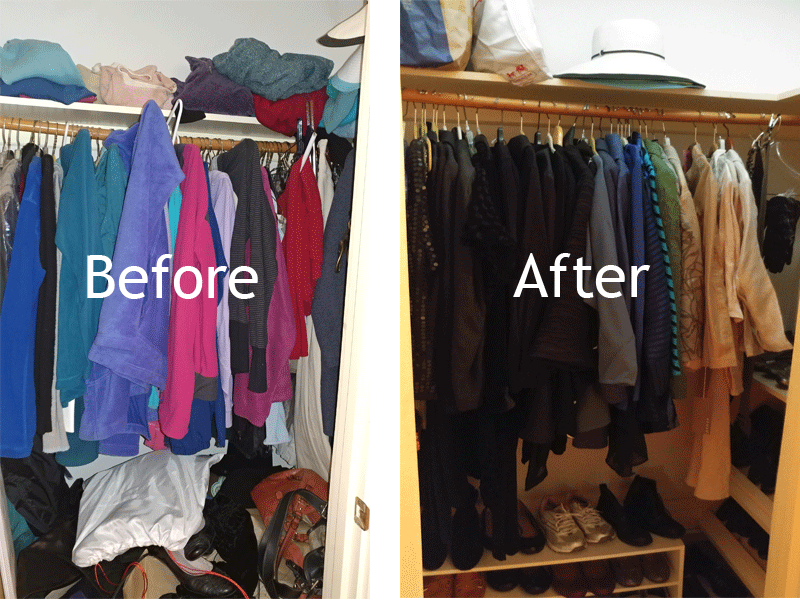Peaceful Place uses the Kon-Mari method of organization, as outlined in the bestselling book The Life-Changing Magic of Tidying Up by Marie Kondo - also as seen in her Netflix series. We make modifications and additions to Kon-Mari to suit our clients’ individual needs.The Kon-Mari method is not a 15-minutes-per-day system. It’s a thorough, all-at-once, wholistic approach to organizing which is not quick or easy but is really the only way to ensure that your clothes are organized in a functional way that is easy to use and maintain. If done right, you only need to do this once!How long will you need to organize your clothes? Anywhere from 4 to 8 uninterrupted hours, maybe more if there is a very large number of items. Step 1: Take “before” photos of your closet and drawers. Make your bed to use it as a staging area. Step 2: Bring every single item of clothing you own from wherever it is - your car, the laundry, your basement, your hall closet, your gym bag - into your bedroom. Step 3: Take all your clothing from your drawers, closets, and elsewhere, and do a rough sort into piles by type: jeans, yoga pants, short-sleeved tops, skirts, socks, etc. You may need to break it down into subcategories (long socks, footie socks, etc.), if you have a lot of clothes. Place the piles on the bed and floor. Leave all items on hangers. Don’t forget shoes and accessories like scarves and handbags. Jewelry can be left for another day!Use sticky notes on the walls to keep track of what is in what pile. Step 4: Once you have sorted every item into the appropriate pile, go through each pile, one piece at a time. Check each piece for stains, holes, or damage. Throw away anything not in good condition. Establish some rules for what to keep and what to discard, for example:
You will donate all items in sizes which no longer work for you.
You will donate all items which you haven’t worn in the last year, with the exception of formal dress clothes (for weddings, etc.) which you haven’t had occasion to wear. Keep only your very favorites in this category, though.
You will donate all items which you haven’t worn much because you don’t really like how they fit, feel, function, or look
You will donate all items you have unnecesarry multiples of (for example, you don’t need to keep 7 black tank tops unless you really do wear (and soil) a black tank top 4 times a week.)
If you have ready access to laundry machines, and do your laundry every other week (most people do it much more often), there is no need to own 27 pairs of footie socks, or 30 pairs of underwear. These items take up a lot of space in drawers.
Put all donated clothing directly into a contactor bag. Put all discard clothing into a different bag.
Step 5: Take the sticky notes you used for sorting and placed them on the front of drawers and on the walls of your closet, indicating where each type of item is to go. Use drawer dividers or containers to separate socks from underwear, for example. If your hanging clothes are on wire hangers, rehang them on thin black velvet hangers. Either throw away the wire hangers or save them to take back to the dry cleaners. Hang the clothes so that the hangers curl around the rod from back to front. After you wear an item, hanging it up going from front to back. After a year, you will see what you have really worn. Hang all like items together, arranging their colors from dark to light, left to right. Use closet rod markers to designate Skirts, Pants, Dresses, etc. Accessories which save space in closets: belt hangers, multi skirt hangers, tank top hangers, etc. If there is space, we recommend hanging your sweaters (here is how to hang them so there are no sweater bumps or stretching.)If you need to store folded items such as sweaters or sweatshirts on the top shelf of your closet, purchase some shelf divers to stop them from cascading sideways all the time. Handbags can be stored on the top shelf, like books. Shoes can either go on the floor of the closet or on a shoe rack. It really depends on the layout of the closet. Remember, the goal is to give hanging clothing “swing room” and to not overstuff your drawers. The fewer items you have, the better it will look and work for you.Step 6: Take the trash bags of discarded clothing and wire hangers directly out to your trash area. Take the containers of clothing to be donated and put them into your car with a note taped on it with the address of where it is to be taken, as well as the date and time you are taking it. Step 7: Take an after photo of all your hard work and share it with your friends! Print a copy of your before photo and tape it in a discreet place in your closet to remind you to maintain your organization and not overshop!



